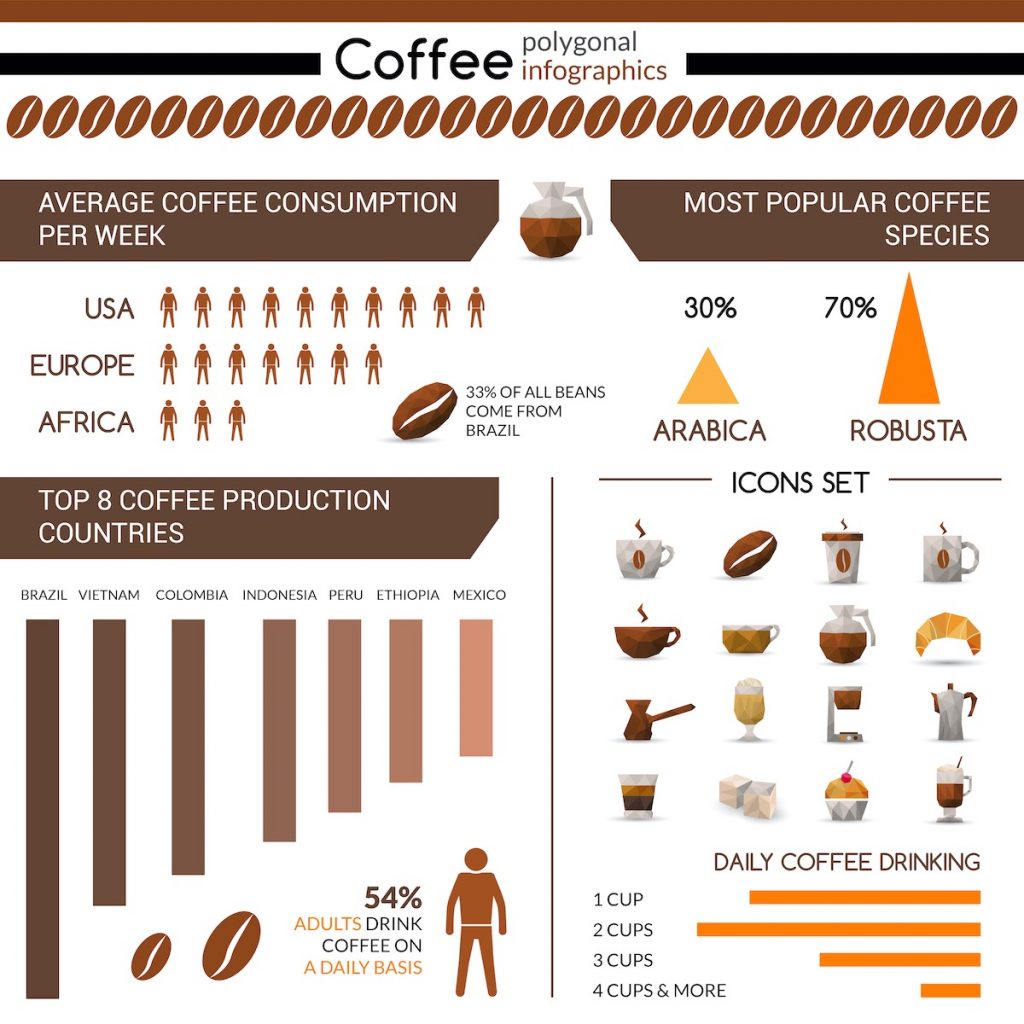Qualities
75% of the coffee beans in the world are Arabica and 25% are robusta.
What is Arabica and what is Robusta coffee?
Arabica beans are grown at high altitudes, on very steep slopes and over 1000 m above sea level. Robusta beans are harvested at lower altitudes and easier to produce and pick. Arabica coffee is therefore more prized for flavor and rarity.
Differences between arabica and robusta
The main differences would be as follows:
- Arabica coffee beans are large and the Robusta coffee beans are small.
- The Arabica coffee beans are extended in shape and the Robusta coffee beans are round.
- The Arabica coffee beans have curved creases and the Robusta coffee straight creases.
- The Arabica is acidic in taste and the Robusta coffee has bitter taste.
- The taste of the Robusta coffee is not as refined as the Arabica.
- Robusta coffee gives more cream than the Arabica coffee, hence better for the instant coffees.
- Robusta coffee has more caffeine compared to the Arabica coffee: 2.7% caffeine compared to 1.5%.
- The Arabica plant grows between 2.5 to 4.5 m compared to the Robusta plant which can reach a height of 4.5 to 6 m.
- Approximately 70-75% of the world´s coffee production are Arabica coffee beans and the Robusta coffee beans are 25-30%.
- Arabica coffee beans give off more of a sweet smell similar to blueberries before roasting whilst Robusta beans smell more nutty before roasting.
- Robusta coffee beans are grown primarily in the African continent and Indonesia while Arabica coffee beans grow in the African continent, Papua New Guinea and especially in South America.
- Of the two types, Robusta is more common given that it is a cheaper coffee.
- Arabica is higher priced- often double the price of Robusta.

What is gourmet coffee?
Gourmet coffee is used to describe quality coffee. Gourmet coffee uses Premium Arabica coffee beans.
What is Specialty Coffee?
A Specialty Coffee is an Arabica coffee that has been graded and has obtained a score of over 80 points out of 100, according to the Specialty Coffee Association (SCA). Usually for microlots.
What is a microlot?
“Microlot” is the new buzzword that’s getting thrown around in the coffee industry left right and center. So what exactly is and is not a microlot coffee?
The best way to explain what microlot coffee is, is this apple orchard analogy: Imagine you have an orchard and most of the trees produce great apples, but you’ve noticed that in one spot of the orchard the apples are phenomenal. Like out of this world better. These apples taste better, are crispier and juicer. So you decide to fence these babies off, water them specially, listen to their every whim and need, and give them all the special attention they deserve. Then when it comes time to harvest, you keep them aside and process them separately, so they are delightfully shiny and good looking. Then you get to sell these special apples to special buyers who will pay top dollar for the top apples.
It’s the same concept with microlot coffees. This small lot of trees usually yield only a small amount of coffee, around 40 bags yearly. The growers and producers identify that is has a special quality (85+ cupping score) so they give more time and attention to developing it’s uniqueness. Microlots are harvested from a particular plot of land, band of altitude and processed in a separate way from the rest of the coffee from the farm, to amplify their special qualities.
Why does grounded coffee get old before roasted coffee?
When grounded, more coffee particles are in contact with the air and therefore will lose freshness sooner.
What you should watch out for when buying coffee:
Do not buy coffee per kilo from open sacks. Coffee beans in open sacks are in contact with heat, light, moisture and air, and therefore get old sooner. Also try to buy coffee from well-sealed and thick packages. The ideal packages are those with one-way valve. When roasted, the coffee beans expel gases. With these one-way valve bags, the gases leave but air does not enter, thus maintaining the coffee bean fresh for longer periods of time. Watch out for packages in see-through or thin paper bags or paper-bags with Windows for sunlight is not good for keeping coffee beans fresh..






